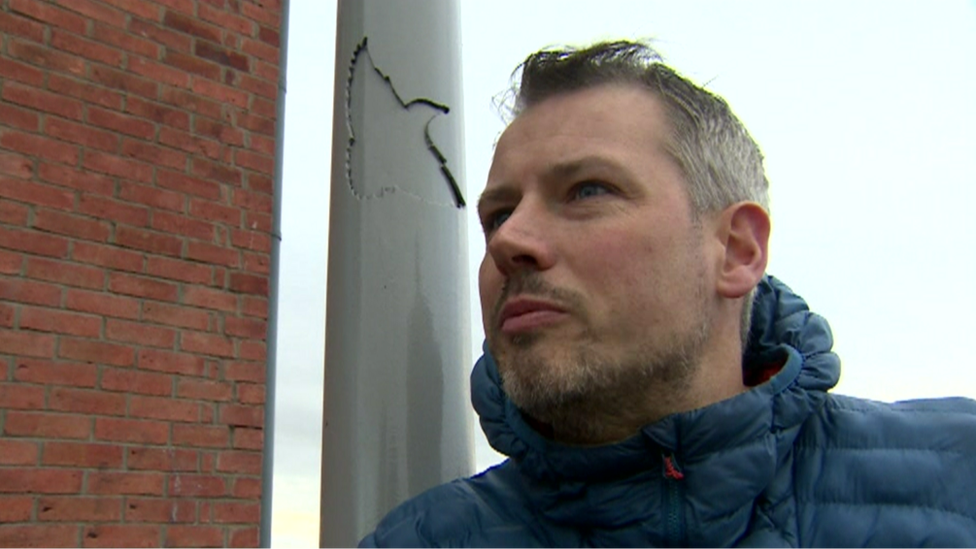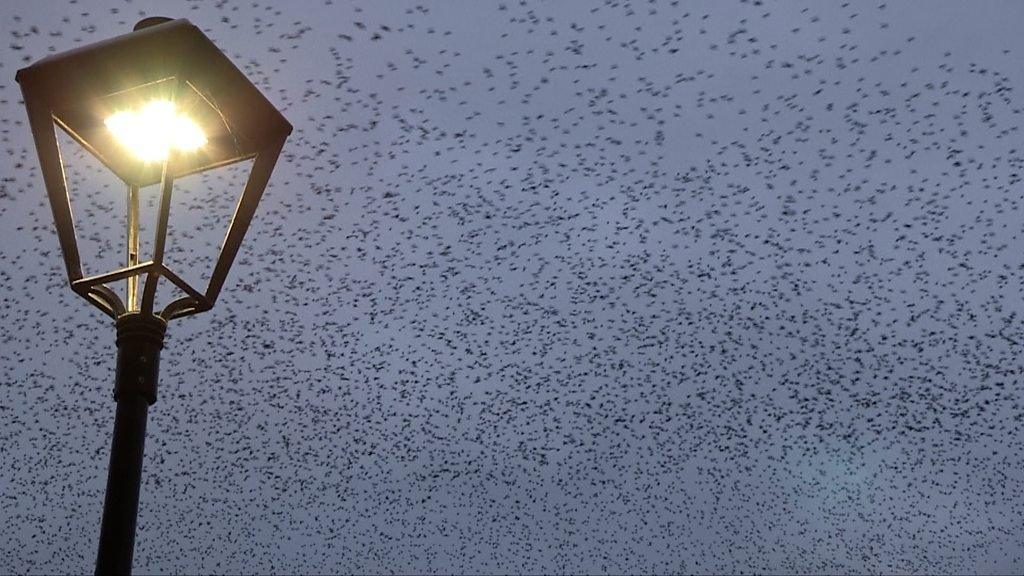Starlings: Did light pollution ruin Belfast murmuration?
- Published
'It was a spectacular murmuration'
Thousands of starlings above the Albert Bridge in Belfast may have been displaced due to light pollution, a conservationist has said.
Large crowds often gathered to watch and photograph the aerial display, known as a murmuration.
But the attraction has all but disappeared, and it is claimed lights on the bridge may have played a role.
A Stormont department said the lighting met the required British and EU safety and environmental standards.
A murmuration is the name given to thousands of birds all swooping and diving in unison.
According to the Royal Society for the Protection of Birds (RSPB) there are a number of reasons why starlings do this, including grouping together for heat and safety.
The murmuration in east Belfast had become an attraction for birdwatchers and the sight was so spectacular that the starlings even appeared on the BBC's Countryfile and The One Show.

Conor McKinney said there were other murmurations throughout Ireland
The RSPB previously warned that murmurations in Northern Ireland were at risk due to a declining wildlife ecosystem.
Conservationist Conor McKinney told Good Morning Ulster that Belfast was once one of the best places in Ireland to watch a starling murmuration.
Mr McKinney said a number of factors might cause displacement, including urban development and climate change.
"Murmurations are something starlings do in really cold weather to try and stay warm. If you have milder, more temperate winters, you lose the murmurations," he said.
"We can rule this out as the root cause, however, since there are still murmurations throughout the island of Ireland and Great Britain."
'Safety in numbers'
The Department for Infrastructure (DFI) upgraded the lighting on the Albert Bridge to brighter LED lanterns in December 2019, but it is not responsible for lighting under the bridge.
Mr McKinney said studies had shown that starlings would avoid areas with lots of light for roosting.
"Light pollution has a direct physiological impact on the birds. It causes extra stress, exposure and prevents them from sleeping," he said.
Swirling starlings gather over Belfast's Albert Bridge in footage from 2019
He said the loss of the birds had "made the city a poorer place to be, it has degraded the natural heritage".
He said lessons needed to be learned about light pollution to ensure wildlife sites were appropriately identified and protected and appropriately managed.
Anne-Marie McDevitt from RSPB NI said starlings were a red-listed species, meaning they are of high conservation concern having declined by two-thirds across the UK since the mid 1970s.
She said the murmuration had been a nature spectacle in the heart of the city.
"Also, roosting together in large numbers is really important for starlings - in these large flocks there is safety in numbers from aerial attacks from birds of prey, and it's thought that when starlings gather they also exchange information about vital food sources," she said.
She said all government departments had a statutory duty to further biodiversity.
"That and the fact the starling is on the government's own priority species list means that the needs of starlings should have been taken into account when carrying out any works on or close to the bridge," she said.
"The starlings can still come back, we'd like to know what is going to be done to make this happen".
A spokesperson for the Department for Infrastructure said: "The street lighting on the road and footways above the bridge were converted to LED in December 2019.
"This lighting was designed in accordance with the current British Standard, BS 5489-1:2020 Design of Road Lighting and meets all of the required British and EU safety and environmental standards."
Related topics
- Published13 January 2019
